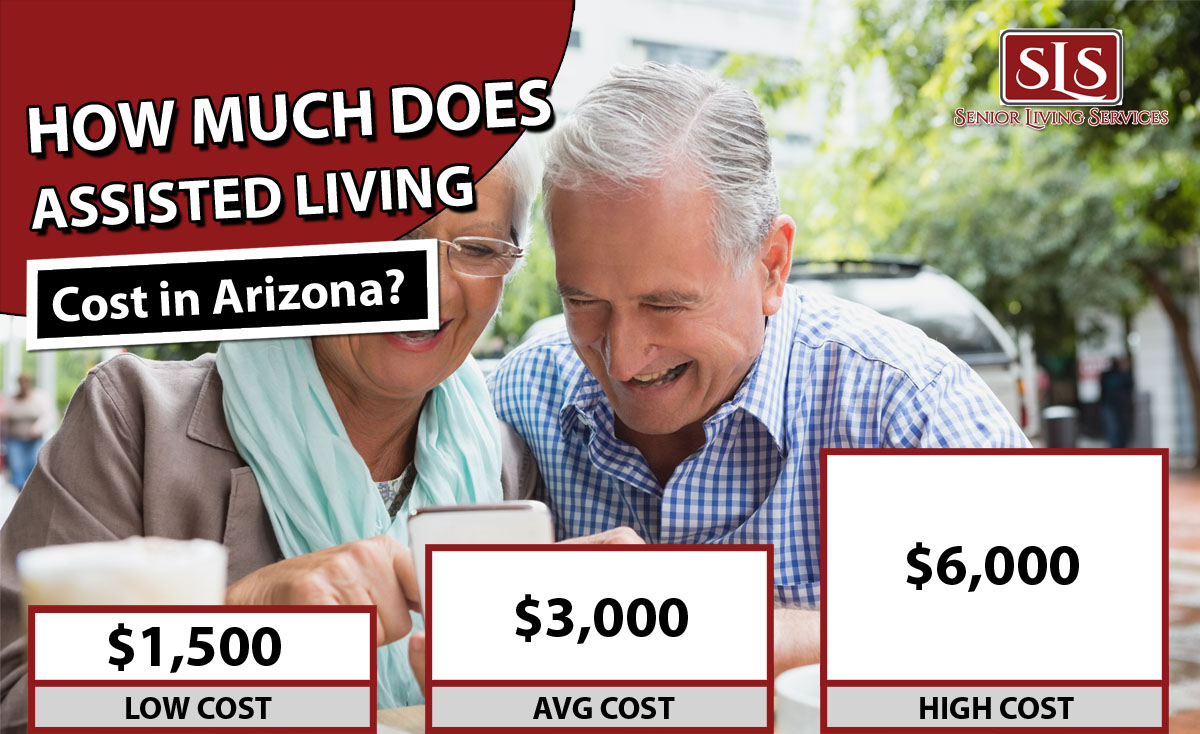Cost of Assisted Living Near Me in Arizona by City
- Phoenix: $3500 per month
- Tucson: $3,695 per month
- Mesa: $3,150 per month
- Chandler: $3,600 per month
- Scottsdale: $4,800 per month
- Glendale: $2,461 per month
- Gilbert: $2,487 per month
- Peoria: $2,948 per month
- Surprise: $3,250 per month
- Sun City: $3,150 per month
- Sun City West: $5,477 per month
- Sedona: $4,005 per month
- Youngtown: $3,293 per month
Phoenix Arizona
According to Bankrate, the average cost of assisted living in Phoenix is $3,500 per month, or $42,000 per year for a 1 bedroom apartment in an assisted living facility. Seniors do not have to make due with these entry level assisted living communities in Phoenix. It is possible to find some very luxurious assisted living options in Phoenix for between $3,000 to $4,000 dollars.
Rates in Phoenix can be hard to understand as each facility has different amenities, floorplans, and options. Don’t disregard some of the higher priced options as once you add up extra costs at a cheaper place, you may pay as much or more!
Tucson Arizona
According to Genworth Cost Of Care Survey, the average cost of assisted living in Tucson, Arizona was about $3,695 per month.
Mesa Arizona
According to Canyon Winds Retirement, This equates to a cost of about $3,150 per month; with low cost average around $1,100 and high costs averaging $6,700. SeniorAdvice states “The average daily cost for assisted living in Mesa, Arizona is approximately $105, with costs running between $37 and $223 per day.”
Chandler Arizona
Assisted Senior Living states that a 1 bedroom apartment in an assisted living facility in Chandler, Arizona will cost you around $3,600 per month.
Scottsdale Arizona
The average cost for a single bedroom apartment in an assisted living facility in Scottsdale is about $4,800, much higher than surrounding cities according to assistedliving.org. This is because Scottsdale is known for their high-end, luxury retirement communities.
Glendale Arizona
SeniorHomes.com has a great article that lists the top Glendale Assisted Living Facilities and their associated costs. According to their list, the average cost of assisted living in Glendale, Arizona is around $2,461.
Gilbert Arizona
Caring.com lists 21 assisted living facilities near Gilbert, AZ, with an average of $2,487 monthly rent costs.
Peoria Arizona
According to Desert Winds Retirement, the average cost of assisted living in Peoria, Arizona is $2,948; with low costs ranging around $2,446 and high costs around $3,447.
Surprise Arizona
Chaparral Winds Retirement states that “Assisted living costs in Surprise, Arizona average $3,250; with high costs ranging around $7,072 and low costs ranging around $2,446.”
Sun City Arizona
Cost of Assisted Living in Sun City, Arizona is around $3,150; with low cost ranging around $1,100 and high cost ranging around $6,700, according to senioradvice.com.
Sun City West Arizona
Cost of Assisted Living in Sun City West, Arizona is around $5,477; with low cost ranging around $2,655 and high cost ranging around $8,300.
Sedona Arizona
According to Sedona Winds Retirement, the cost of Assisted Living in Sedona, Arizona is around $4,005; with low cost ranging around $2,206 and high cost ranging around $5,804. Sedona is one of the best places to retire in Arizona.
Youngtown Arizona
Ventana Winds Retirement states that the cost of Assisted Living in Youngtown, Arizona is around $3,293; with high costs ranging around $4,141 and low costs ranging around$2,446.
How To Find Assisted Living Arizona
You can browse assisted living facilities online on SeniorAdvisor.com or SLSCommunities.com to get an idea of what the properties look like, what kind of amenities they have, and what floor plans are available. You will also have a chance to hear from residents and their families who have left reviews about their own person experiences at assisted living facilities. Reading about assisted living communities online helps narrow down the list of places you’d like to visit when deciding on where you’d enjoy living. It’s important to keep in mind if the community offers transportation and the distance from shopping, entertainment, and medical services.
Once you have a list of best options it is a great idea to schedule a few tours of your top assisted living facilities. While you’re there tour the inside and outside looking for how well the landscaping is kept along with the overall cleanliness of the facility. The very best facilities will typically offer to let you sample a meal during your tour.
Assisted Living Budgeting & Value
Before choosing which facility you’d like to live in; take stock is which services you need right now, and also those that you might need in the near future. Choosing a location that can accommodate your needs today and, in the future, makes it much easier than having to go through the whole process of finding a new senior living facility if the one you’re living in doesn’t have the services you need. Many of the best assisted living facilities have other on-site communities that can offer additional services, should the need arise.
Choose an assisted living community where the costs for living, services, meals, and other costs are all listed separately and compare it to other facilities where the living conditions are similar but they offer all-inclusive pricing. There is a chance you will see that there are costs put into all-inclusive pricing that you have no need for and could save money living somewhere that allows you to pick and choose what you need.
Paying For Assisted Living In Arizona
Funding for assisted living in Phoenix differs greatly based on each senior’s financial situation. A common resource for assisted living is Medicaid. There are some assisted living options in Phoenix which don’t accept Medicaid, so it is important to ask that question if you believe you’ll need it, before you schedule a tour. The Medicaid Program in Arizona helps provide payment for long-term care services, as well as Medicaid health coverage, to eligible seniors who, because of their medical condition, require help or assisted with daily living activities such as transportation, grooming, dressing, bathing and eating.
Seniors with better financial standing can use a combination of retirement money and social security to fund more luxurious alternative assisted living options. In some cases, even equity from the family real estate can be used by selling the property or taking a mortgage against it. In addition, some families choose to rent the real estate as an additional source of monthly income to help pay for assisted living services. Financial planners can help you and your family explore the very best options for how to fund the assisted living costs for a facility you want to live in.





